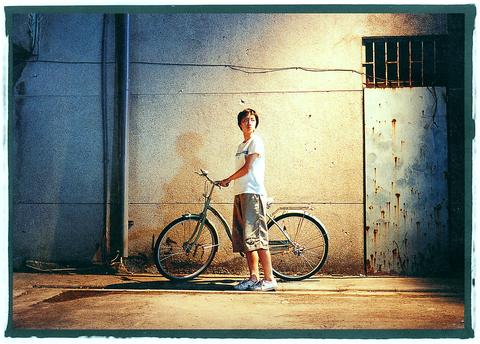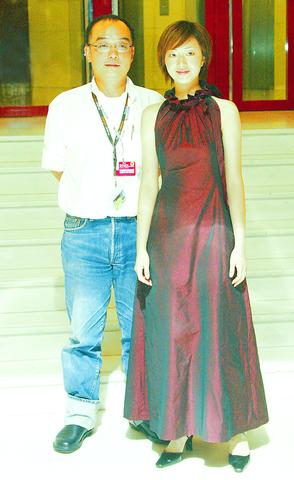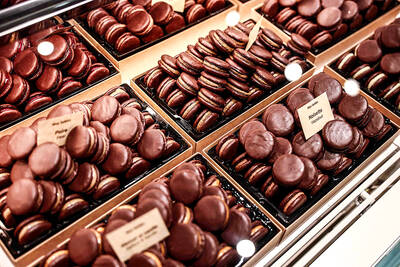Many have cried walking out of the movie theater after watching Taiwanese director Yee Chih-yen's (
Following Tuesday's well-received screening at the Hotel Noga Hilton, the main site of the Director's Fortnight section of this year's Cannes International Film Festival, audience and journalists alike filed into the press conference to fire off a seemingly endless stream of questions about the film. Both Yee and his producer, Peggy Chiao (

PHOTO COURTESY OF ARC LIGHT
French journalists referred to Blue Gate as a "gay" film, a categorization with which Yee took issue. "For me, it's not a film about homosexuality. It's rather a film about young people coping with their problems in life," Yee said.

PHOTO: YU SEN-LUN, TAIPEI TIMES
The film is set in a Taipei City high school and looks at the life of three teens during an unforgettable summer. Guei Lun-mei (
Lin Yue-zhen, played by Liang Shu-hui (
Lin goes to the swimming pool every night to spy on Zhang, who sneaks into the closed swimming pool to practice. She collects the used bottles of mineral water Zhang finishes. She asks Meng, her best friend, to pass a love letter to Zhang."I want to be friends with you," she writes, but the "sunshine boy" becomes attached to the messenger, Meng, and waits around her door.
Zhang, a blithe spirit, is a guileless boy. "I'm Zhang from swimming team and guitar club. I'm not bad!" he always says to Meng. His two dearest wishes are to win the swimming championship and to become Meng's sweetheart. He's unaware of the secret Meng is about to tell him, the secret that might have them taste a melancholy they've never before tasted.
The Blue Gate Crossing is a seemingly simple light story about Taipei's teenagers looking inwards to see their souls.
Yee excels at exploring the intimate world of the main character, Meng -- her troubled self-image and emotionally tumultuous world. She's precocious and knows about loneliness earlier than her classmates. Although she has a nice heart and is friendly to Lin and Zhang, and also a gym teacher who becomes attracted to her, she cannot let them into her world.
"I feel sympathy with the character because I also feel a lot of solitude," Guei said. "It was not that difficult to enter the role. I feel that in reality there must be confused girls like Meng," she said.
Yee perfectly captures the nuances of being a teenager in middle-class Taipei. "We auditioned nearly 4000 teenagers and finally found Guei and Chen from the Hsimenting area last summer," Yee said.
In order to faithfully depict the world of high school, Yee went to school with the students everyday for two weeks. Yee is experienced in dealing with teenage subjects.
Having done several TV dramas about teenagers in previous years, he became a devoted observer of youth in Taipei.
"A lot of stories about teenagers have imposed too much moral judgement on their world. But I want a story from the teenager's point of view. They should find their own right or wrong," Yee said.
This experience being with youngsters made it easy for Yee to direct the three real high school students. "Two crucial parts -- Meng kissing her best friend, and Meng revealing the secret to Chen -- only took one take to shoot. The actors really entered the world of the story," Yee said.
The result revealed in the film is Yee's sharpness and preciseness about the value of being young and how an adolescent mind suddenly becomes an adult mind. This sharpness also gives weight and a certain melancholy to the film's conclusion.
"The blue gate is a symbol for me in the film. It's an image of the future. Everyone has a blue gate in their hearts," Yee said. "As for the melancholy, it's probably me. It's just how I think," he said.

Many people noticed the flood of pro-China propaganda across a number of venues in recent weeks that looks like a coordinated assault on US Taiwan policy. It does look like an effort intended to influence the US before the meeting between US President Donald Trump and Chinese dictator Xi Jinping (習近平) over the weekend. Jennifer Kavanagh’s piece in the New York Times in September appears to be the opening strike of the current campaign. She followed up last week in the Lowy Interpreter, blaming the US for causing the PRC to escalate in the Philippines and Taiwan, saying that as

Nov. 3 to Nov. 9 In 1925, 18-year-old Huang Chin-chuan (黃金川) penned the following words: “When will the day of women’s equal rights arrive, so that my talents won’t drift away in the eastern stream?” These were the closing lines to her poem “Female Student” (女學生), which expressed her unwillingness to be confined to traditional female roles and her desire to study and explore the world. Born to a wealthy family on Nov. 5, 1907, Huang was able to study in Japan — a rare privilege for women in her time — and even made a name for herself in the

Would you eat lab-grown chocolate? I requested a sample from California Cultured, a Sacramento-based company. Its chocolate, not yet commercially available, is made with techniques that have previously been used to synthesize other bioactive products like certain plant-derived pharmaceuticals for commercial sale. A few days later, it arrives. The morsel, barely bigger than a coffee bean, is supposed to be the flavor equivalent of a 70 percent to 80 percent dark chocolate. I tear open its sealed packet and a chocolatey aroma escapes — so far, so good. I pop it in my mouth. Slightly waxy and distinctly bitter, it boasts those bright,

“Taiwanese increasingly reluctant to give their lives to defend the island,” trumpeted a South China Morning Post (SCMP) headline last week. The survey asked whether people should be prepared to pay any price — including death — to protect Taiwan and prevent “reunification.” “The poll found that 52.2 percent of those questioned were unwilling to do so — an 8.4-point rise compared with a similar survey carried out two years ago — while 40.8 percent were willing, down four points on the previous survey,” the article said. Treated as anti-Taiwan propaganda, the piece was sent around by the usual pro-China suspects